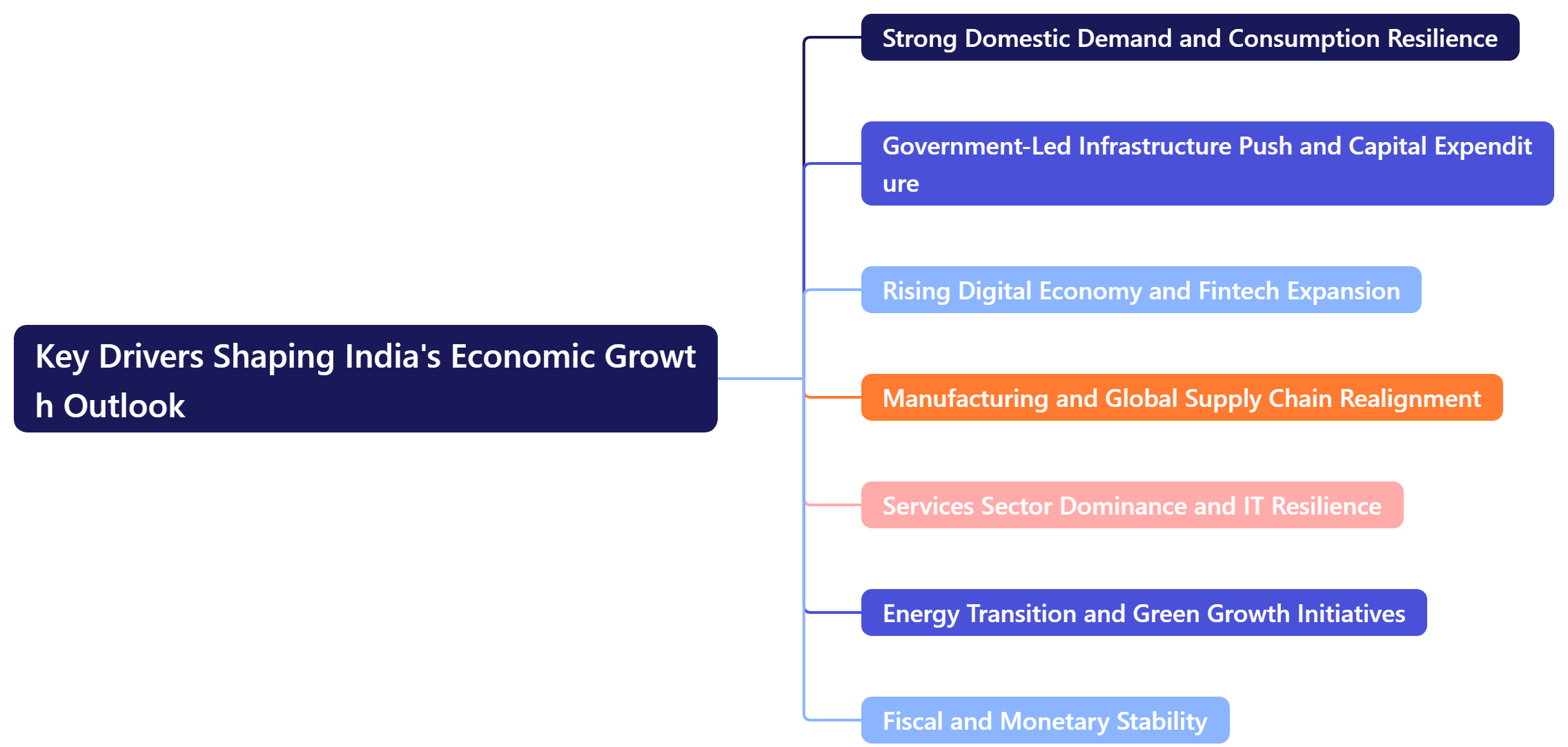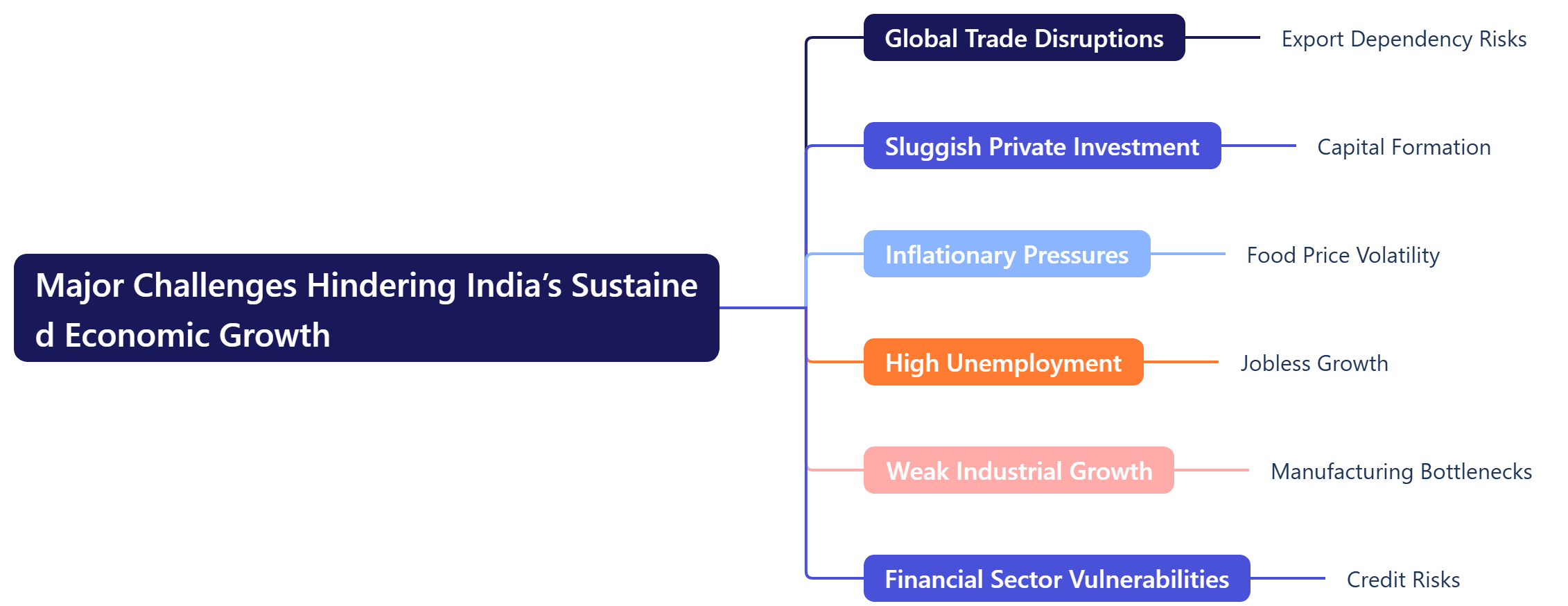|
India economic growth in Q3 FY 2024-25 stood at a moderate 6.2%, falling slightly below the government’s full-year target of 6.5%. The primary sectors were the key drivers of growth, while the manufacturing and services sectors exhibited signs of vulnerability.
Key Drivers Shaping India Economic Growth Outlook

- Strong Domestic Demand and Consumption Resilience
- Rising Middle-Class Wealth: India’s large consumer base, expanding middle class, and urbanization continue to drive demand, particularly in sectors like FMCG, e-commerce, and automobiles.
- Rural and Urban Growth: Rural demand is strengthening due to higher agricultural output and government support, while urban consumption benefits from rising disposable incomes.
- Consumption Trends: Private consumption expenditure grew 6.9% in Q3 FY25 (Deloitte Report), with FMCG sales increasing by 4% (April–June 2024), signaling strong demand recovery.
- Government-Led Infrastructure Push and Capital Expenditure
- Massive Public Investments: Large-scale projects under National Infrastructure Pipeline (NIP), Gati Shakti, and Bharatmala are boosting economic activity, employment, and private investment.
- Increased Budget Allocations: The ₹11.21 lakh crore capital expenditure in Budget 2025-26 has enhanced logistics, transportation, and urban infrastructure.
- Capex Growth: Capital expenditure grew at a CAGR of 38.8% between FY20-FY24 (Economic Survey 2024-25).
- Tax Relief for Consumers: The no-income tax policy for earnings up to ₹12 lakh will increase disposable income, further driving consumption and demand.
- Healthcare Savings: Schemes like Ayushman Bharat lower healthcare expenses, leaving more money in people’s pockets to stimulate demand.
- Rising Digital Economy and Fintech Expansion
- Digital Financial Growth: India’s rapid adoption of digital payments, fintech innovations, and e-governance is expanding financial inclusion and tax compliance.
- UPI and Digital Infrastructure: The Unified Payments Interface (UPI), ONDC, and Digital Public Infrastructure (DPI) have significantly reduced cash dependency.
- Economic Contribution: India’s digital economy contributed 11.74% to GDP in 2022-23.
- UPI Growth: Transactions hit a record high in January 2025, with 16.99 billion transactions valued at ₹23.48 lakh crore.
- Manufacturing and Global Supply Chain Realignment
- PLI Scheme Impact: The Production-Linked Incentive (PLI) scheme has attracted ₹1.46 lakh crore in investments, creating 9.5 lakh jobs.
- Electronics and Exports Growth: In FY23, electronics exports totaled $23.6 billion, with mobile phones contributing 43%.
- Global Supply Chain Shift: Geopolitical tensions, trade disruptions (e.g., Red Sea, Suez Canal), and the China+1 strategy are prompting firms to shift supply chains to India.
- Services Sector Dominance and IT Resilience
- Growth Engine of the Economy: The services sector continues to lead growth, driven by IT, finance, tourism, and real estate.
- AI and Digital Innovation: The rise of AI, digital services, and fintech has increased global demand for Indian IT expertise.
- Strong Services Exports: India’s services exports grew 12.8% during April–November FY25, compared to 5.7% in FY24 (Economic Survey 2024-25).
- Energy Transition and Green Growth Initiatives
- Renewable Energy Expansion: India’s green energy transition is reshaping its industrial and economic landscape, with strong investments in solar, wind, EVs, and green hydrogen.
- Capacity Growth: As of October 2024, renewable energy capacity stood at 203.18 GW, contributing 46.3% of total installed capacity.
- Green Hydrogen Market: India is targeting an $8 billion green hydrogen market by 2030, reinforcing its clean energy commitments.
- Fiscal and Monetary Stability
- Prudent Fiscal Management: Government policies focused on inflation control, fiscal discipline, and tax reforms have bolstered macroeconomic stability.
- Stable Fiscal Outlook: The fiscal deficit is expected to decline to 4.9% of GDP in FY25, down from 5.1% in the previous estimate.
- Inflation Trends: Retail inflation eased to 4.9% in FY25, though food inflation remains high at 8.4%.
- Tax Reforms and GST Impact:
- The GST regime has simplified taxation, reducing costs for businesses and consumers.
- For example, automobile tax rates, previously 28%-45%, have now dropped to 18%-28%, making vehicles more affordable.
- The elimination of cascading taxes has further reduced commodity prices, boosting demand and efficiency.
These factors collectively position India’s economy for sustained growth, despite global uncertainties and domestic challenges.
Major Challenges Hindering India Sustained Economic Growth

- Global Trade Disruptions and Export Dependency Risks
- Geopolitical Tensions and Protectionism: India’s export growth is vulnerable to trade policy shifts and protectionist measures by major economies like the US and EU.
- Shipping Route Disruptions: Blockages in key trade routes, such as the Suez Canal and Red Sea, have increased freight costs, affecting export competitiveness.
- Tariff Hikes on Indian Goods: The US plans a 25% import tariff on Indian pharmaceuticals, threatening billions in annual exports.
- Rising Freight Costs: Due to Suez Canal disruptions, rerouting via the Cape of Good Hope has increased shipping costs by 20%, contributing to imported inflation.
- Sluggish Private Investment and Capital Formation
- Slow Recovery in Private Sector Investment: Despite government-driven infrastructure spending, private investment remains sluggish due to policy uncertainties, global slowdown, and cautious investor sentiment.
- Weaker Business Confidence: Gross Fixed Capital Formation (GFCF) growth has slowed, reflecting low business confidence and capital formation.
- Dependence on Incentives: The manufacturing sector remains highly reliant on government incentives, rather than organic expansion and market-driven growth.
- Declining GFCF Growth: Growth in Gross Fixed Capital Formation slowed to 5.4% in Q2 FY25, indicating weak investment momentum.
- Inflationary Pressures and Food Price Volatility
- Erratic Monsoons and Supply Chain Issues: Food prices remain volatile due to weather fluctuations, supply chain disruptions, and geopolitical uncertainties.
- Rising Global Commodity Prices: Energy and raw material costs have surged, making inflation control more challenging.
- Impact on Consumer Confidence: Unstable food prices can reduce household purchasing power and limit monetary policy flexibility.
- High Food Inflation: Inflation remains elevated at 8.4%, driven by onion, tomato, and pulse shortages (Economic Survey 2024-25). Higher logistics costs further increase consumer prices.
- High Unemployment and Jobless Growth
- Limited Job Creation: Despite economic growth, employment generation remains inadequate, particularly in manufacturing and formal sectors.
- Automation and AI Impact: Rising adoption of automation and artificial intelligence (AI) is displacing jobs in traditional industries.
- Low Skill Development: A large portion of India’s workforce lacks essential skills, posing a risk to its demographic dividend.
- Labor Market Challenges:
- Unemployment rate fell to 3.2% (2023-24), but labor force participation remains below global averages.
- The Economic Survey 2023-24 states that 65% of India’s population is under 35, but only 51.25% of youth are employable due to skill gaps.
- Weak Industrial Growth and Manufacturing Bottlenecks
- Structural Challenges: India’s manufacturing sector struggles with low productivity, high logistics costs, and dependence on imported critical components.
- Domestic Bottlenecks: Issues like land acquisition hurdles, rigid labor laws, and inadequate infrastructure slow industrial expansion.
- Uneven Growth Across Sectors: While PLI schemes have benefited select industries, broader manufacturing growth remains inconsistent.
- Slowdown in Industrial Growth:
- Manufacturing growth decelerated to 2.2% in Q2 FY25.
- Logistics costs remain high at 13-14% of GDP, making Indian exports less competitive.
- Financial Sector Vulnerabilities and Credit Risks
- Rising Unsecured Lending: While India’s banking sector has improved, concerns remain over the rise in unsecured loans and fintech-related credit risks.
- Growing Personal Debt:
- Unsecured personal loans grew at a CAGR of 22% in the three years leading to FY24.
- Credit card borrowings surged at 25% CAGR, raising concerns about potential defaults and financial instability.
These challenges pose significant hurdles to India’s long-term economic growth and require policy interventions, structural reforms, and targeted investments to ensure sustained progress.
Steps India Can Take to Sustain Its Economic Growth Outlook

- Strengthening Domestic Demand and Consumption
- Enhancing Disposable Income: Implementing targeted tax reliefs, rural employment programs, and direct benefit transfers will support household consumption.
- Expanding Credit Access: Improving access to credit for MSMEs and households will boost purchasing power and demand-driven growth.
- Promoting Value-Added Sectors: Encouraging processed food, textiles, and electronics industries will generate employment and expand the consumer base.
- Strengthening Agricultural Supply Chains: Enhancing cold storage infrastructure, warehousing, and logistics will reduce food price volatility.
- Improving Consumer Confidence: Strengthening consumer protection laws and digital literacy will foster trust in e-commerce and fintech services.
- Boosting Private Investment and Industrial Growth
- Simplifying Business Regulations: Easing land acquisition laws, labor codes, and environmental clearances will reduce compliance burdens and enhance the ease of doing business.
- Expanding PLI Schemes: Extending Production-Linked Incentive (PLI) schemes to sectors like green hydrogen, semiconductors, and precision manufacturing will drive industrial expansion.
- Encouraging Foreign Direct Investment (FDI): Attracting FDI in high-tech and capital-intensive industries will strengthen domestic manufacturing capabilities.
- Strengthening Infrastructure and Logistics Efficiency
- Accelerating Key Infrastructure Projects: Fast-tracking initiatives under the National Infrastructure Pipeline (NIP), Gati Shakti, and Bharatmala will enhance connectivity and reduce logistics costs.
- Modernizing Urban Transport and Ports: Expanding high-speed rail corridors, urban transport networks, and port infrastructure will improve trade competitiveness.
- Investing in Renewable Energy: Providing incentives for green projects and decentralized energy grids will ensure a sustainable power supply.
- Enhancing Capex Utilization: Ensuring efficient use of capital expenditure at the state level will expedite project implementation.
- Promoting Digital Transformation and Innovation
- Scaling Up Technology Infrastructure: Expanding 5G networks, AI-driven automation, and cloud computing will boost efficiency in services and manufacturing.
- Supporting Small Businesses and Startups: Strengthening the Open Network for Digital Commerce (ONDC) and Digital Public Infrastructure (DPI) will provide a level playing field for smaller enterprises.
- Encouraging R&D and Innovation: Offering tax incentives and fostering university-industry collaboration in fields like AI, quantum computing, and biotechnology will drive technological leadership.
- Enhancing Trade Competitiveness and Export Diversification
- Strengthening Trade Agreements: Negotiating free trade agreements (FTAs) with economies like the EU, UK, and ASEAN will improve market access and reduce tariff barriers.
- Boosting High-Value Exports: Expanding incentives for electronics, pharmaceuticals, and precision engineering will enhance India’s global trade position.
- Improving Trade Logistics: Upgrading port efficiency, digitizing customs, and reducing logistics costs will streamline trade processes.
- Expanding Rupee Trade Mechanisms: Promoting rupee-based trade with key partners will help mitigate forex risks and strengthen economic diplomacy.
- Addressing Employment and Skill Development Gaps
- Expanding Vocational Training: Strengthening apprenticeship programs, vocational education, and industry-academia collaboration will align workforce skills with industry needs.
- Enhancing Employability Initiatives: Strengthening Skill India and National Education Policy (NEP) 2020 programs will equip graduates with relevant skills and reduce structural unemployment.
- Promoting Labor-Intensive Sectors: Encouraging growth in textiles, tourism, and construction will generate sustainable job opportunities.
- Supporting Entrepreneurship in Smaller Cities: Boosting startup incubation and entrepreneurial ecosystems in Tier-2 and Tier-3 cities will help create decentralized employment hubs.
By implementing these strategic measures, India can sustain its economic growth, enhance resilience, and position itself as a global economic powerhouse.
India’s economic growth trajectory remains optimistic, despite short-term challenges. The economy continues to be driven by robust domestic demand, large-scale infrastructure development, rapid digital transformation, and expanding manufacturing capabilities.
By implementing strategic reforms, encouraging private sector investment, and fostering innovation, India can achieve long-term, sustainable, and inclusive economic growth, even amidst global uncertainties.
|




